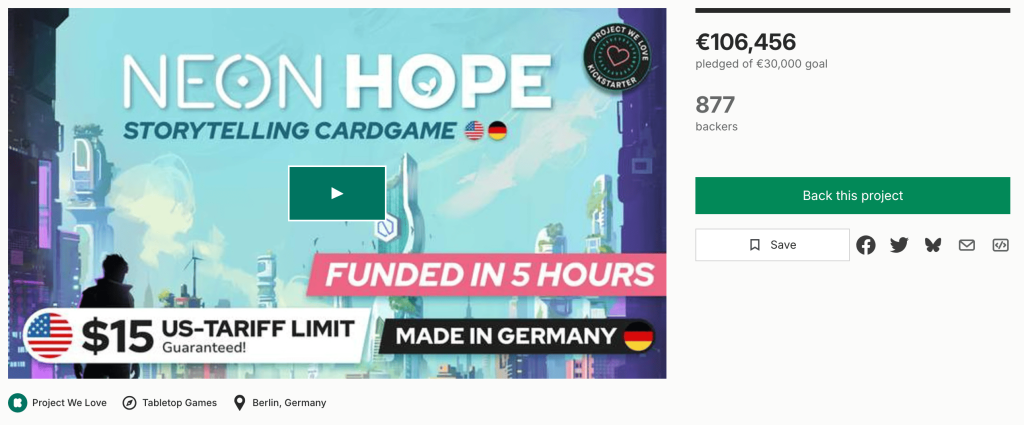Is board game crowdfunding for you? So you’ve created a board game. Maybe it’s a fun party game, an RPG or a family-friendly card game. No matter the genre, the dream is the same: to publish your board game and get it into the hands of players around the world. But how do you turn that dream into reality? The answer for many creators lies in board game crowdfunding.
Whether you’re launching on Kickstarter, Gamefound, or simply want to understand the best way to self publish a board game, this guide covers everything you need to know about the top platforms, strategies, and a practical roadmap to make it all happen.
What Is Board Game Crowdfunding?
Board game crowdfunding is the process of raising money from a community of supporters—often gamers and fans—who pledge funds in exchange for a copy of your game, exclusive rewards, or simply to support your vision. Platforms like Kickstarter for board games and Gamefound have helped thousands of creators bring their tabletop games to life.
Unlike traditional publishing, crowdfunding gives creators direct control and a chance to validate their idea before mass production. It also builds a community of early supporters who can amplify your launch and drive future sales.
Crowdfunding also allows you to test your game concept with minimal risk. Instead of investing thousands of dollars into printing and warehousing your board game upfront, you can gauge demand and fine-tune your design based on backer feedback.
Kickstarter for Board Games: Why It’s the #1 Platform
If you’re wondering how to make a board game and get it in front of an audience, Kickstarter is still the reigning king. It has the largest board game backer community in the world. There are projects like Neon Hope that have used Kickstarter for board game crowdfunding.
Benefits of Kickstarter for Board Game Creators
- Massive audience: 80% of all game projects funded on Kickstarter in 2024 were tabletop games. That’s millions of dedicated board game enthusiasts already browsing the platform.
- All-or-nothing model: You only get charged (and receive funds) if your campaign hits its goal, which reassures backers and ensures you raise enough to fulfill promises.
- Proven success stories: From Exploding Kittens to Gloomhaven y Frosthaven, many iconic games started here and went on to become household names.
Things to Consider
Running a Kickstarter board game campaign requires a polished prototype and campaign page. You’ll need gameplay videos, a clear breakdown of components, pledge tiers, stretch goals, and delivery timelines. Most successful campaigns also rely heavily on pre-launch marketing—Kickstarter is a powerful platform, but it rewards those who bring their own crowd.
Expect to pay about 5% in platform fees, plus ~3% in payment processing. You’ll also need to plan for taxes, manufacturing, and shipping—especially global logistics, which can quickly eat into your funding if miscalculated.
Despite the work, Kickstarter remains the best platform to publish a board game from scratch. Its backer community is highly engaged, and many gamers actively seek out new titles to support.

Gamefound: A Kickstarter Alternative for Board Game Crowdfunding
Gamefound is a newer but fast-growing alternative to Kickstarter, built specifically for tabletop creators. Originally created as a pledge manager, it now supports full crowdfunding campaigns. It’s backed by Awaken Realms and used by major publishers for big-box games and expansions.
Why Choose Gamefound?
- Tailored for board games: Features like built-in pledge management, multilingual support, and component previews.
- High average funding: Although fewer campaigns run on Gamefound, those that do often raise more per backer.
- All-in-one ecosystem: You can manage your campaign, late pledges, add-ons, and fulfillment—all on one platform.
Gamefound is ideal for creators with an existing fanbase, deluxe games, or campaigns that benefit from more advanced tools than Kickstarter currently offers. However, it’s still smaller in reach and may require more effort to generate traffic.
Indiegogo: A Flexible But Less Common Option
Indiegogo allows for both fixed and flexible funding, which means you can choose to keep whatever you raise (even if you don’t hit your goal). This can be attractive for some creators, especially those outside the regions Kickstarter supports.
However, Indiegogo is less well-known in the tabletop space. Its community skews more toward tech gadgets and innovations, making board game crowdfunding campaigns harder to find and fund. That said, some creators have used it for reprints, late pledges, or regional campaigns.
Be cautious: while flexible funding sounds appealing, it can hurt trust with backers. Many prefer the all-or-nothing model because it ensures the creator has the resources to deliver.
Choosing the Right Platform to Publish Your Board Game
Here’s a quick comparison of the three major crowdfunding platforms:
| Platform | Best For | Key Strengths | Considerations |
|---|---|---|---|
| Kickstarter | Most creators, especially first-time ones | Largest audience, trusted for board games | Competitive, requires strong marketing |
| Gamefound | Deluxe games and experienced publishers | Integrated pledge management, tabletop-only | Less discoverability for new creators |
| Indiegogo | Flexible funding or niche campaigns | More relaxed entry, flexible models | Lower success rate for board games |
Ultimately, the best platform for you depends on your audience, goals, and resources. Many creators start on Kickstarter and use Gamefound or BackerKit for pledge management. Some larger publishers migrate to Gamefound once they’ve built up a following.
Essential Tips for a Successful Board Game Crowdfunding Campaign
Regardless of platform, the following tips are crucial to turn your idea into a funded campaign:
1 – Build Your Audience Early
Start building your community 6–12 months before launch. Use newsletters, social media, Discord servers, and playtesting groups to generate buzz. A strong email list will outperform any social platform when it comes to converting backers.
2 – Invest in Quality Visuals
First impressions count. Hire an artist or graphic designer to create appealing component previews. Showcase your game with clean renders or photos, and invest in a gameplay video. These assets make a massive difference in how backers perceive your project.
3 – Price Carefully
Do market research and calculate costs for manufacturing, shipping, taxes, and platform fees. Include buffer room. Pricing too low may hurt your ability to deliver; pricing too high may discourage backers.
4 – Engage with Your Community
Respond to questions, post regular updates, and build excitement during the campaign. Share stretch goals, behind-the-scenes content, and polls. Active campaigns attract more backers.
How to Publish a Board Game in 12 months
If you’re serious about board game crowdfunding, you need a clear timeline. Here’s a step-by-step plan to help you launch within a year.
Foundation Phase (Month 1 – 2)
At this point you should begin playtesting with friends and local groups. Create social media accounts and a basic website or landing page. When you have this, you could also start gathering an email list to send updates straight to their inbox.
Build a Community & Get Feedback on your Board Game (Month 3 – 4)
Get yourself out there: Attend protospiel events or board game conventions. Use your socials and online communities to share design updates, art teasers, and theme reveals. That way, you could invite early followers to test print-and-play versions. Basically, what you want is to build hype and collect opinions from playtesters.
Plan For Production (Month 5 – 6)
Reach out to manufacturers, no need to look for them in your country, but if they are close for quotes. Budget production and fulfillment based on different print runs and start thinking about how you are going to distribute your game.
Media and Marketing Assets (Month 7 – 8)
Get ready your final art, packaging mockups, and anything you may need. Film a trailer and gameplay explanation. If you have prototypes ready, contact reviewers and YouTubers (send prototypes early to get people excited!).
Campaign Setup (Month 9 – 10)
Draft your campaign page with text, images, and rewards. Then, open your Kickstarter, Indiegogo or Gamefound (or any platform you want to use) pre-launch page.
You also want to start to get your community involved in the process to get people engaged. Run polls for stretch goals, cover art variants, etc. If you have a discord community or are part of communities where you are showing of your game, share more content. This is also the moment to start begin countdown campaigns on social media and newsletters.
Testing and Feedback (Month 11 – 12)
- Show your draft campaign to mentors, other designers, or online communities.
- Revise pledge tiers and stretch goals based on feedback.
- Finalize your manufacturing and shipping plan.
Launch Day (Month 12)
This is it. Launch your campaign. Email your list and post across platforms and be online all day to answer comments and boost traction.
During the Campaign
Post updates weekly, you want to have your audience engaged and asure people things are going well. Unlock stretch goals strategically as you meet your goals and keep backers excited with artwork reveals, livestreams, and progress bars.
After the Campaign
Confirm funds and get all your backer data organized. Make sure everything is going well with productions and start sending out the copies of your games. Also, and this is very important, maintain monthly updates until delivery. Don’t let people get restless, they’ve given you their support.
From Crowdfunding to Publishing a Board Game: What Happens Next?
Board game crowdfunding is just the beginning. Once your campaign is over, you’ll enter the production and fulfillment phase. This is where planning pays off: you’ll need to manage files, proofing, factory timelines, freight shipping, warehousing, and individual backer fulfillment.
Kickstarter for board games is always a fantasitc tool to publish a board game. It’s for sure the most known one for the general public. Tools like BackerKit or Gamefound’s pledge manager can help manage shipping fees and late pledges. You may also want to work with fulfillment partners like Quartermaster Logistics or Spiral Galaxy to handle pick-and-pack and international logistics. However, you could always try an do it yourself.
When your backers start receiving the game and posting pictures or reviews, it opens the door to new opportunities: retail sales, localizations, conventions, and even expansions.
If you’ve handled the campaign well and delivered on time, your next game will benefit from a loyal audience eager for more.
So… Is Board Game Crowdfunding for you?
Crowdfunding platforms like Kickstarter y Gamefound have revolutionized how creators launch and publish board games. With the right preparation, clear vision, and commitment to quality, almost anyone can bring their tabletop game to life.
Remember, the key to a successful board game crowdfunding campaign isn’t just a cool idea—it’s about building a community, delivering trust, and showing backers why your game is worth supporting.
So if you’re ready to take your prototype to the next level, follow this roadmap and start building your dream campaign today.
And don’t forget: Tabletop Creator gives you the tools to prototype, test, and build your components with ease—so you’re one step closer to showing the world your next big board game hit.


